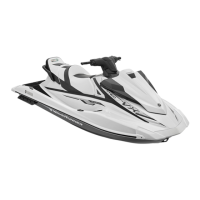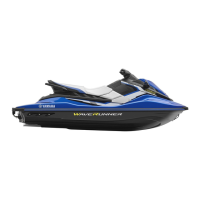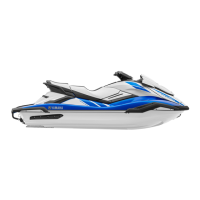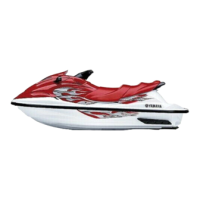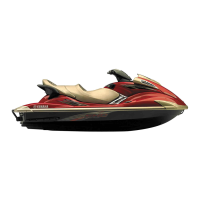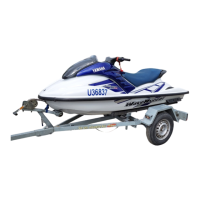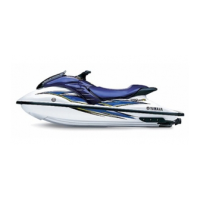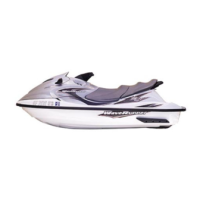Do you have a question about the Yamaha WaveRunner EX 2023 and is the answer not in the manual?
Locates PRI-ID, HIN, and engine serial numbers for part ordering and theft protection.
Details engine conformity to EPA/CARB regulations and fuel certification.
Highlights critical safety warnings related to operation and rider safety.
Covers operator age, passenger limits, and pre-operation checks for safe riding.
Explains waterway navigation rules, including right-of-way and vessel encounters.
Emphasizes treating others, nature, and maintaining the watercraft responsibly.
Defines key terms used in the manual, such as speed types and watercraft parts.
Illustrates and labels external and internal components of the watercraft.
Explains the operation of essential controls like engine stop and start switches.
Details how to use the throttle and RiDE levers for speed and reverse control.
Describes how handlebar movement affects jet thrust direction and watercraft steering.
Covers functions like reverse systems and shift indicators for different models.
Provides step-by-step instructions for safely starting the engine while on the water.
Explains techniques for turning, stopping safely, and operating in reverse.
Details the displays and indicators for fuel level, speed, and engine status.
Explains alerts for fuel level, oil pressure, engine overheat, and check engine warnings.
Describes how to access and use seats and various storage areas.
Covers handgrips, reboarding steps, and bow/stern eyes for handling and safety.
Specifies recommended fuel types, octane ratings, and refueling procedures.
Details recommended engine oil, types, grades, and checking the oil level.
Provides guidance on securely trailering the watercraft to prevent damage.
Essential steps for breaking in the engine to ensure longevity and performance.
Comprehensive checklist of items to inspect before launching the watercraft.
Detailed checks for fuel systems, engine compartment, bilge water, and battery.
Checks to perform after launching and starting the engine in the water.
Procedures after use, including flushing cooling passages and cleaning.
Guidance on maintaining and storing the battery, including removal and charging.
Instructions for lubricating moving parts and rustproofing the watercraft.
Schedule for regular checks and servicing based on hours or time intervals.
Instructions and recommendations for changing the engine oil and filter.
Lists common problems, their possible causes, remedies, and page references.
Guidance for handling emergencies like jet intake blockage or battery issues.
Details the terms, conditions, and exclusions of the watercraft's limited warranty.
Information on optional extended service plans for continued protection.
Locates PRI-ID, HIN, and engine serial numbers for part ordering and theft protection.
Details engine conformity to EPA/CARB regulations and fuel certification.
Highlights critical safety warnings related to operation and rider safety.
Covers operator age, passenger limits, and pre-operation checks for safe riding.
Explains waterway navigation rules, including right-of-way and vessel encounters.
Emphasizes treating others, nature, and maintaining the watercraft responsibly.
Defines key terms used in the manual, such as speed types and watercraft parts.
Illustrates and labels external and internal components of the watercraft.
Explains the operation of essential controls like engine stop and start switches.
Details how to use the throttle and RiDE levers for speed and reverse control.
Describes how handlebar movement affects jet thrust direction and watercraft steering.
Covers functions like reverse systems and shift indicators for different models.
Provides step-by-step instructions for safely starting the engine while on the water.
Explains techniques for turning, stopping safely, and operating in reverse.
Details the displays and indicators for fuel level, speed, and engine status.
Explains alerts for fuel level, oil pressure, engine overheat, and check engine warnings.
Describes how to access and use seats and various storage areas.
Covers handgrips, reboarding steps, and bow/stern eyes for handling and safety.
Specifies recommended fuel types, octane ratings, and refueling procedures.
Details recommended engine oil, types, grades, and checking the oil level.
Provides guidance on securely trailering the watercraft to prevent damage.
Essential steps for breaking in the engine to ensure longevity and performance.
Comprehensive checklist of items to inspect before launching the watercraft.
Detailed checks for fuel systems, engine compartment, bilge water, and battery.
Checks to perform after launching and starting the engine in the water.
Procedures after use, including flushing cooling passages and cleaning.
Guidance on maintaining and storing the battery, including removal and charging.
Instructions for lubricating moving parts and rustproofing the watercraft.
Schedule for regular checks and servicing based on hours or time intervals.
Instructions and recommendations for changing the engine oil and filter.
Lists common problems, their possible causes, remedies, and page references.
Guidance for handling emergencies like jet intake blockage or battery issues.
Details the terms, conditions, and exclusions of the watercraft's limited warranty.
Information on optional extended service plans for continued protection.
| Displacement | 1049 cc |
|---|---|
| Seating Capacity | 3 |
| Fuel Capacity | 50 liters |
| Top Speed | 50 mph |
| Engine Type | 4-stroke, 3-cylinder, TR-1 |
